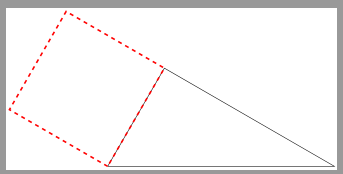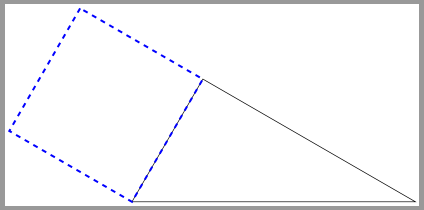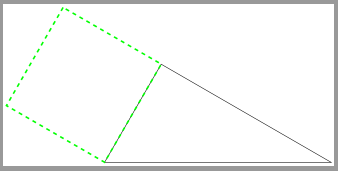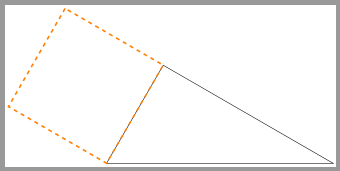|
Ich möchte bei folgendem Beispiel ein Quadrat über der linken "schiefen" Seiten des Dreiecks haben. \documentclass[border=2pt]{standalone} \usepackage{tikz} \usetikzlibrary{intersections} \begin{document} \begin{tikzpicture} \coordinate (A) at (0,0); \coordinate (B) at (6,0); \path[name path=a] (B) -- ++(150:5.5); \path[name path=b] (A) -- ++(60:3.5); \path[name intersections={of=a and b}] (intersection-1) coordinate (C); \draw (A) -- (B) --(C) -- (A); \end{tikzpicture} \end{document} Ich hab keine Idee, wie man das umsetzt. Ich hab gefunden, dass man mit |
|
Lade einfach die TikZ Bibliothek ($<coordinate>!<faktor>!<winkel>:<second coordinate>$) Damit ist eine Koordinate gemeint, die Das Quadrat kannst Du entsprechend mit \draw[red,very thick,dashed](A)--($(A)!1!90:(C)$)--($(C)!1!-90:(A)$)--(C)--cycle; zeichnen.
Code: \documentclass[border=2pt]{standalone} \usepackage{tikz} \usetikzlibrary{intersections} \usetikzlibrary{calc} \begin{document} \begin{tikzpicture} \coordinate (A) at (0,0); \coordinate (B) at (6,0); \path[name path=a] (B) -- ++(150:5.5); \path[name path=b] (A) -- ++(60:3.5); \path[name intersections={of=a and b}] (intersection-1) coordinate (C); \draw (A) -- (B) --(C) -- (A); \draw[red,very thick,dashed] (A)--($(A)!1!90:(C)$)--($(C)!1!-90:(A)$)--(C)--cycle; \end{tikzpicture} \end{document} Geht das vll. auch mit einem
(28 Feb '15, 21:23)
cis
Wenn schon ein Node, dann tut es auch ein einfacher quadratischer?
(28 Feb '15, 21:59)
esdd
Perfekt! Danke!
(01 Mär '15, 18:45)
tom75
Das ist schon die beste Lösung - im TikZ-Handbuch, Kap.
(02 Mär '15, 17:07)
cis
|
|
Auf Anregung von @cis ist hier noch eine Alternative, bei der der Abstand zwischen den Punkten \documentclass[border=2pt]{standalone} \usepackage{tikz} \usetikzlibrary{intersections} \usetikzlibrary{calc} \begin{document} \begin{tikzpicture} \coordinate (A) at (0,0); \coordinate (B) at (6,0); \path[name path=a] (B) -- ++(150:5.5); \path[name path=b] (A) -- ++(60:3.5); \path[name intersections={of=a and b}] (intersection-1) coordinate (C); \draw (A) -- (B) --(C) -- (A); \path let \p1=($(C)-(A)$), \n1={veclen(\x1,\y1)} in (A)node[draw,blue,dashed,very thick, minimum size=\n1, outer sep=0pt,inner sep=0pt, anchor=south west, rotate=60 ]{}; \end{tikzpicture} \end{document}
Da @cis sich das Quadrat als Dekoration der Strecke vorstellt, ist hier ein noch etwas umständlicherer Vorschlag, bei dem zusätzlich die \documentclass[border=2pt]{standalone} \usepackage{tikz} \usetikzlibrary{intersections} \usetikzlibrary{calc} \usetikzlibrary{decorations.shapes} \tikzset{ decorate with square/.style={ decorate, outer sep=0pt, decoration={ shape backgrounds, shape=rectangle, anchor=south, shape size=#1, shape evenly spread=1 } } } \begin{document} \begin{tikzpicture} \coordinate (A) at (0,0); \coordinate (B) at (6,0); \path[name path=a] (B) -- ++(150:5.5); \path[name path=b] (A) -- ++(60:3.5); \path[name intersections={of=a and b}] (intersection-1) coordinate (C); \draw (A) -- (B) --(C) -- (A); \path let \p1=($(C)-(A)$), \n1={veclen(\x1,\y1)} in [draw=green,dashed,very thick,decorate with square=\n1] (A)--(C); \end{tikzpicture} \end{document} Ergebnis:
Und da @cis unbedingt lieber ein \documentclass[border=2pt]{standalone} \usepackage{tikz} \usetikzlibrary{intersections} \usetikzlibrary{calc} \usetikzlibrary{decorations.shapes,shapes.geometric} \tikzset{ decorate with square/.style={ decorate, outer sep=0pt, decoration={ shape backgrounds, shape=regular polygon, anchor=south, shape size=#1, shape evenly spread=1 }, regular polygon sides=4 } } \begin{document} \begin{tikzpicture} \coordinate (A) at (0,0); \coordinate (B) at (6,0); \path[name path=a] (B) -- ++(150:5.5); \path[name path=b] (A) -- ++(60:3.5); \path[name intersections={of=a and b}] (intersection-1) coordinate (C); \draw (A) -- (B) --(C) -- (A); \path let \p1=($(C)-(A)$), \n1={veclen(\x1,\y1)} in [draw=orange,dashed,very thick,decorate with square=\n1] (A)--(C); \end{tikzpicture} \end{document}
Ich dachte an sowas wie
(01 Mär '15, 20:38)
cis
@cis Ich habe jetzt auch noch eine Variante mit
(01 Mär '15, 23:32)
esdd
Ich finde die Methode gar nicht so schlecht, bloß hat die decoration-lib scheints keinen einfachen Positionierungsmechanismus.
PS: Ah und ich sehe gerade noch, das ist immer noch kein "
(02 Mär '15, 13:32)
cis
@cis Ich habe Dir jetzt auch noch eine Version mit
(02 Mär '15, 14:18)
esdd
Ja so ist das gut, kapiert bloß niemand mehr :D
(02 Mär '15, 14:39)
cis
|




